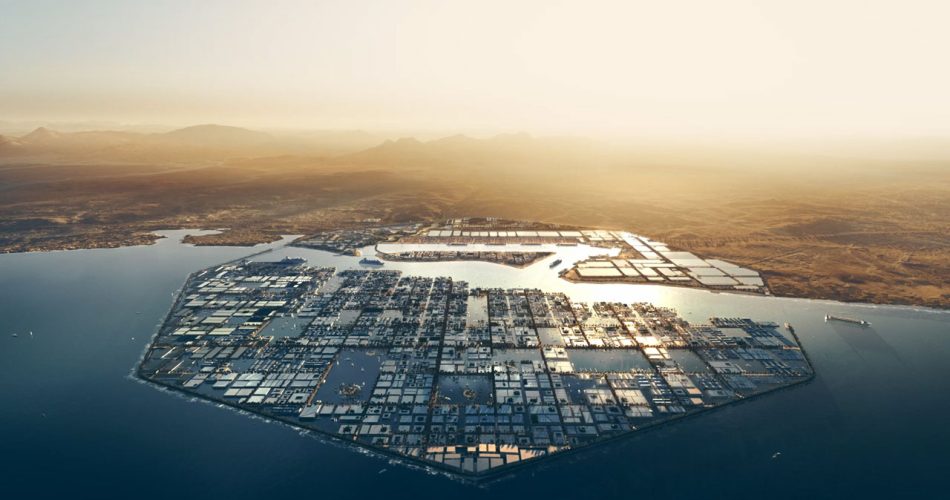A new district of the NEOM project
It all starts from NEOM, a broader concept that is also a closed joint-stock company created in 2017 and belonging to the Saudi Public Investment Fund. The goal is to create an economic hub developing along the Aqaba Gulf and Saudi Arabia’s Red Sea coastline.
The NEOM idea is made up of two words: neo, a Greek prefix that means “new,” and mustaqbal, the Arabic term which means “future”.
The NEOM Smart City, which will be located in the province of Tabuk in northwestern Saudi Arabia, and The Line, a series of linear cities that will span the Middle Eastern country, are both part of the project in which sustainability and the environment, in addition to technology, play an important role.
The developers claim that urban design focuses on people rather than infrastructures and that walkability would define everyday life. That’s why all the important daily services, such as schools, medical clinics, recreational facilities, and green spaces, will be within a 5-minute walk.
Neom is described as a “living laboratory” including towns and cities, ports and business zones, research institutes, sports and entertainment venues, and tourism sites.
- 100% renewable energy: It’s placed in one of the few sites in the world where solar power, wind energy, and green hydrogen can be produced cheaply and in huge amounts. Saudi Arabia’s master plan seeks to generate non-oil earnings and attract foreign investment through innovative proposals that will help the country expand economically.
- Water: NEOM will be a regional water production and storage powerhouse, with a focus on desalination. NEOM’s water distribution network will be totally connected through an advanced Internet of Water architecture, supplying high-quality drinking water and recycled water while also removing wastewater. In addition, water quality monitoring, smart irrigation, and leak detection will all be handled in real-time.
The Line is a never-before-seen urbanization model, a 170km-long linear urban development comprising various, hyper-connected communities, with walkable neighborhoods interwoven with public parks and the natural landscape. It is a 21st-century and beyond model of urban planning and livability in connection with nature.

The Line will transform urban life as we know it, allowing NEOM to become an economic powerhouse for the Kingdom of Saudi Arabia.
- Powered by 100% renewable energy.
- Within a five-minute walk, you’ll be able to meet all of your basic daily needs.
- People, not vehicles, will be at the center of communities, which will be easily accessible and designed for convenience and walkability.
- A physical and digital infrastructure layer, fully integrated under the surface and containing key utilities and transportation services.
- The infrastructure spine will provide communities with ultra-high-speed mass transit access.
- Open space, parks, gardens, the natural environment, and sustainable food production will all be seamlessly interwoven in communities that live in peace with nature.
- Over 90% of the data in NEOM will be evaluated to deliver a predictive system with ever-improving services to residents and companies through a digital framework including Artificial Intelligence and robotics that continuously learn and evolve.
- The communities will be self-sufficient and represent the personalities of the people who live there, as well as the region and the industries that exist there.
In addition, a new floating hexagonal industrial area in Neom was recently launched by the company, called Oxagon.
Oxagon will be a curated landscape of sophisticated industry that closes the loop and promotes circularity, resulting in a clean energy system that substitutes renewables for disposables, reduces waste, and maximizes productivity. Located in northwest Saudi Arabia, it offers a new way of life and work that has a significant impact on business while having a minimal impact on the environment.
It will include:
- A hub for advanced and clean manufacturing;
- A living lab for research and innovation;
- Next-gen automated and integrated port and supply chain with global connectivity;
- Exceptional livability;
- 100% clean energy.
Industries that will be part of Oxagon:
- Renewable energy: solar PV, green hydrogen, battery storage, on-shore wind.
- Autonomous and sustainable mobility: autonomous pods and shuttles, urban air mobility, green heavy-duty commercial vehicles, green watercraft.
- Modern construction: modular construction, 3D printing, sustainable steel, zero-emission heavy machinery.
- Water innovation: seawater desalination, brine management, wastewater treatment, system management devices.
- Sustainable food production: greenhouses, aquaculture, alternative meat, sustainable packaging.
- Health and wellbeing: pharma, biotech, nutrition, medtech.
- Technology and digital: industrial, service, and general-purpose robots, communication infrastructure for 5G+, space systems, electronic components, and 3D printing equipment.
Other projects that will follow Oxagon:
- The Rig, is a theme park in the Arabian Gulf built on top of an abandoned oil rig.
- The Prince Mohammed Bin Salman Non-Profit City, a planned city district in Riyadh’s capital that would be home to nonprofits and sustainable businesses.
It’s an ambitious project that surely gives an idea of the next future where people will live more connected with nature without giving up on technology which will help improve people’s life and their value.
Source tomorrow.city
